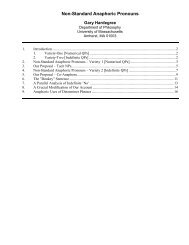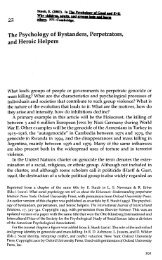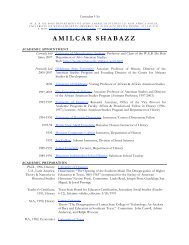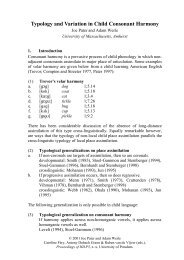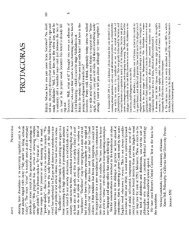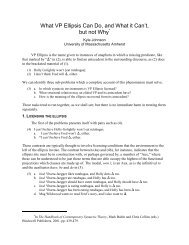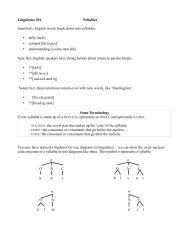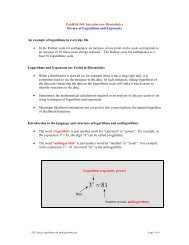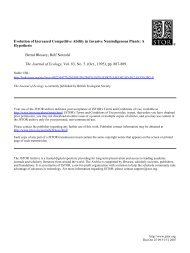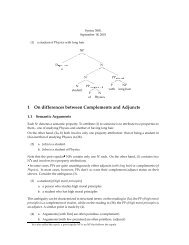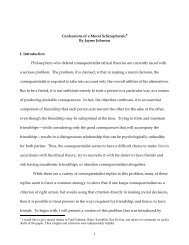Aristotle's Definitions of the Soul: "De Anima" ii, 1-3
Aristotle's Definitions of the Soul: "De Anima" ii, 1-3
Aristotle's Definitions of the Soul: "De Anima" ii, 1-3
You also want an ePaper? Increase the reach of your titles
YUMPU automatically turns print PDFs into web optimized ePapers that Google loves.
organs.6 This apparent inconsistency holds, moreover, not only between<br />
<strong>the</strong> third definition and things Aristotle says elsewhere. It holds between<br />
<strong>the</strong> third definition and <strong>the</strong> second. The second definition requires only<br />
that to be ensouled7 a body must be in a certain state <strong>of</strong> readiness to engage<br />
in one or ano<strong>the</strong>r life function, whe<strong>the</strong>r it has organs or not. It will be said<br />
that Aristotle wants to argue in <strong>the</strong> <strong>De</strong> A nima that only a body with organs<br />
could be in such a state. But he doesn't argue for this. At best he merely<br />
claims it (412 a 28, f.). And even this he does not do unambiguously. For he<br />
allows that if a thing engages regularly by nature in patterned change <strong>of</strong><br />
place that is enough to make it alive (413 a 22-25). We know that he<br />
believes that <strong>the</strong> stars and <strong>the</strong> spheres in which <strong>the</strong>y move do this and that<br />
he denies that <strong>the</strong>y have organs. So we have good reason to want <strong>the</strong> second<br />
definition <strong>of</strong> soul to cover <strong>the</strong> stars. If it covers <strong>the</strong> stars, however, <strong>the</strong>n it<br />
seems incompatible with <strong>the</strong> third definition.<br />
It might be argued that <strong>the</strong> second and third definitions are not meant to<br />
be equivalent on <strong>the</strong> ground that <strong>the</strong> "body with organs" mentioned in <strong>the</strong><br />
third definition is explicitly introduced in <strong>the</strong> text as a body <strong>of</strong> a more<br />
restricted type than <strong>the</strong> "body which has life potentially" <strong>of</strong> <strong>the</strong> second<br />
definition (412 a 27 - b 1). If this were so we could take <strong>the</strong> second<br />
definition, which covers <strong>the</strong> stars, as <strong>the</strong> accurate one and regard <strong>the</strong> third<br />
as covering not all <strong>of</strong> <strong>the</strong> living but only a certain part <strong>of</strong> it. But <strong>the</strong> third<br />
definition is said to mention "something common to every soul" (412 b 4).<br />
The fourth definition introduces fur<strong>the</strong>r problems. It apparently says<br />
that any natural body which has an internal source <strong>of</strong> patterned change is<br />
ensouled. But in <strong>the</strong> Physics (192 b 9-23) Aristotle claims that all <strong>the</strong><br />
familiar natural bodies have an internal source <strong>of</strong> patterned change. (Cf.<br />
<strong>De</strong> Caelo 268 b 27, ff.). So on his definition rocks would seem to be alive.<br />
And Aristotle would deny that rocks are alive (<strong>De</strong> Anima 412 a 13-15).<br />
Some will urge that this fourth claim is not a definition, that it only gives a<br />
necessary condition for being an ensouled body and no more. But it must<br />
do more to play <strong>the</strong> role Aristotle gives to it in its context (412 b 10-17). He<br />
argues that <strong>the</strong> thing that keeps an axe from being alive is that it doesn't as<br />
an axe have <strong>the</strong> kind <strong>of</strong> natural body that engages in its proper motion -<br />
chopping - in <strong>the</strong> cgurse <strong>of</strong> nature from some internal impulse. But rocks<br />
do engage in <strong>the</strong>ir proper motion under internal impulse in <strong>the</strong> course <strong>of</strong><br />
nature (Physics 192 b 12, ff. at b 18). So <strong>the</strong> argument would seem to<br />
require that <strong>the</strong>y are alive. Even if we treat <strong>the</strong> fourth claim as giving only a<br />
necessary condition for being alive, moreover, that still creates problems.<br />
For, again, <strong>the</strong> stars are alive and, hence, ensouled and <strong>the</strong>y do not engage<br />
in any proper natural movement under internal impulse (<strong>De</strong> Caelo 290 a<br />
261



